Exploring 4,7-Disubstituted Pyrimido[4,5-d]pyrimidines as Antiviral and Anticancer Agents
Abstract
1. Introduction
2. Results and Discussion
2.1. Chemistry
2.2. Biological Assays
2.2.1. Antiviral Activity
2.2.2. Anti-Proliferative Activity
3. Materials and Methods
3.1. General Information
3.2. Synthesis of Compounds 7a–7m
3.3. Biological Assays and Experiments
4. Conclusions
Supplementary Materials
Author Contributions
Funding
Institutional Review Board Statement
Informed Consent Statement
Data Availability Statement
Conflicts of Interest
References
- Uribe, M.L.; Marrocco, I.; Yarden, Y. EGFR in Cancer: Signaling Mechanisms, Drugs, and Acquired Resistance. Cancers 2021, 13, 2748. [Google Scholar] [CrossRef] [PubMed]
- Martellucci, S.; Clementi, L.; Sabetta, S.; Mattei, V.; Botta, L.; Angelucci, A. Src Family Kinases as Therapeutic Targets in Advanced Solid Tumors: What We Have Learned So Far. Cancers 2020, 12, 1448. [Google Scholar] [CrossRef]
- Huang, C.; Ji, C.; Wang, J. Current Thoughts on Cellular Functions of Numb-Associated Kinases. Mol. Biol. Rep. 2023, 50, 4645–4652. [Google Scholar] [CrossRef]
- Karelou, M.; Kampasis, D.; Kalampaliki, A.D.; Persoons, L.; Krämer, A.; Schols, D.; Knapp, S.; De Jonghe, S.; Kostakis, I.K. Synthesis and Biological Evaluation of 2-Substituted Quinazolin-4(3H)-Ones with Antiproliferative Activities. Molecules 2023, 28, 7912. [Google Scholar] [CrossRef] [PubMed]
- Weisberg, E.; Parent, A.; Yang, P.L.; Sattler, M.; Liu, Q.; Liu, Q.; Wang, J.; Meng, C.; Buhrlage, S.J.; Gray, N.; et al. Repurposing of Kinase Inhibitors for Treatment of COVID-19. Pharm. Res. 2020, 37, 167. [Google Scholar] [CrossRef] [PubMed]
- Beerli, C.; Yakimovich, A.; Kilcher, S.; Reynoso, G.V.; Fläschner, G.; Müller, D.J.; Hickman, H.D.; Mercer, J. Vaccinia Virus Hijacks EGFR Signalling to Enhance Virus Spread through Rapid and Directed Infected Cell Motility. Nat. Microbiol. 2019, 4, 216–225. [Google Scholar] [CrossRef]
- Wang, X.; Huong, S.-M.; Chiu, M.L.; Raab-Traub, N.; Huang, E.-S. Epidermal Growth Factor Receptor Is a Cellular Receptor for Human Cytomegalovirus. Nature 2003, 424, 456–461. [Google Scholar] [CrossRef]
- Wang, X.; Huang, D.Y.; Huong, S.-M.; Huang, E.-S. Integrin Avβ3 Is a Coreceptor for Human Cytomegalovirus. Nat. Med. 2005, 11, 515–521. [Google Scholar] [CrossRef]
- Weller, M.L.; Amornphimoltham, P.; Schmidt, M.; Wilson, P.A.; Gutkind, J.S.; Chiorini, J.A. Epidermal Growth Factor Receptor Is a Co-Receptor for Adeno-Associated Virus Serotype 6. Nat. Med. 2010, 16, 662–664. [Google Scholar] [CrossRef]
- Eierhoff, T.; Hrincius, E.R.; Rescher, U.; Ludwig, S.; Ehrhardt, C. The Epidermal Growth Factor Receptor (EGFR) Promotes Uptake of Influenza A Viruses (IAV) into Host Cells. PLoS Pathog. 2010, 6, e1001099. [Google Scholar] [CrossRef]
- Lupberger, J.; Zeisel, M.B.; Xiao, F.; Thumann, C.; Fofana, I.; Zona, L.; Davis, C.; Mee, C.J.; Turek, M.; Gorke, S.; et al. EGFR and EphA2 Are Host Factors for Hepatitis C Virus Entry and Possible Targets for Antiviral Therapy. Nat. Med. 2011, 17, 589–595. [Google Scholar] [CrossRef] [PubMed]
- Diao, J.; Pantua, H.; Ngu, H.; Komuves, L.; Diehl, L.; Schaefer, G.; Kapadia, S.B. Hepatitis C Virus Induces Epidermal Growth Factor Receptor Activation via CD81 Binding for Viral Internalization and Entry. J. Virol. 2012, 86, 10935–10949. [Google Scholar] [CrossRef] [PubMed]
- Schleiss, M.; Eickhoff, J.; Auerochs, S.; Leis, M.; Abele, S.; Rechter, S.; Choi, Y.; Anderson, J.; Scott, G.; Rawlinson, W.; et al. Protein Kinase Inhibitors of the Quinazoline Class Exert Anti-Cytomegaloviral Activity in Vitro and in Vivo. Antivir. Res. 2008, 79, 49–61. [Google Scholar] [CrossRef] [PubMed]
- Zeisel, M.B.; Crouchet, E.; Baumert, T.F.; Schuster, C. Host-Targeting Agents to Prevent and Cure Hepatitis C Virus Infection. Viruses 2015, 7, 5659–5685. [Google Scholar] [CrossRef]
- Parsons, S.J.; Parsons, J.T. Src Family Kinases, Key Regulators of Signal Transduction. Oncogene 2004, 23, 7906–7909. [Google Scholar] [CrossRef]
- Puhl, A.C.; Gomes, G.F.; Damasceno, S.; Fritch, E.J.; Levi, J.A.; Johnson, N.J.; Scholle, F.; Premkumar, L.; Hurst, B.L.; Lee-Montiel, F.; et al. Vandetanib Blocks the Cytokine Storm in SARS-CoV-2-Infected Mice. ACS Omega 2022, 7, 31935–31944. [Google Scholar] [CrossRef]
- Shin, J.S.; Jung, E.; Kim, M.; Baric, R.S.; Go, Y.Y. Saracatinib Inhibits Middle East Respiratory Syndrome-Coronavirus Replication In Vitro. Viruses 2018, 10, 283. [Google Scholar] [CrossRef]
- Pillaiyar, T.; Meenakshisundaram, S.; Manickam, M. Recent Discovery and Development of Inhibitors Targeting Coronaviruses. Drug Discov. Today 2020, 25, 668–688. [Google Scholar] [CrossRef]
- Neveu, G.; Ziv-Av, A.; Barouch-Bentov, R.; Berkerman, E.; Mulholland, J.; Einav, S. AP-2-Associated Protein Kinase 1 and Cyclin G-Associated Kinase Regulate Hepatitis C Virus Entry and Are Potential Drug Targets. J. Virol. 2015, 89, 4387–4404. [Google Scholar] [CrossRef]
- Tang, G.; Liu, Z.; Chen, D. Human Coronaviruses: Origin, Host and Receptor. J. Clin. Virol. 2022, 155, 105246. [Google Scholar] [CrossRef]
- Santacroce, L.; Charitos, I.A.; Carretta, D.M.; De Nitto, E.; Lovero, R. The Human Coronaviruses (HCoVs) and the Molecular Mechanisms of SARS-CoV-2 Infection. J. Mol. Med. 2021, 99, 93–106. [Google Scholar] [CrossRef] [PubMed]
- Liu, D.X.; Liang, J.Q.; Fung, T.S. Human Coronavirus-229E, -OC43, -NL63, and -HKU1 (Coronaviridae). In Encyclopedia of Virology, 4th ed.; Bamford, D.H., Zuckerman, M., Eds.; Academic Press: Oxford, UK, 2021; pp. 428–440. ISBN 978-0-12-814516-6. [Google Scholar]
- Blair, H.A. Remdesivir: A Review in COVID-19. Drugs 2023, 83, 1215–1237. [Google Scholar] [CrossRef]
- Bernal, A.J.; Silva, M.M.G.d.; Musungaie, D.B.; Kovalchuk, E.; Gonzalez, A.; Reyes, V.D.; Martín-Quirós, A.; Caraco, Y.; Williams-Diaz, A.; Brown, M.L.; et al. Molnupiravir for Oral Treatment of COVID-19 in Nonhospitalized Patients. N. Engl. J. Med. 2022, 386, 509–520. [Google Scholar] [CrossRef] [PubMed]
- Iketani, S.; Mohri, H.; Culbertson, B.; Hong, S.J.; Duan, Y.; Luck, M.I.; Annavajhala, M.K.; Guo, Y.; Sheng, Z.; Uhlemann, A.-C.; et al. Multiple Pathways for SARS-CoV-2 Resistance to Nirmatrelvir. Nature 2023, 613, 558–564. [Google Scholar] [CrossRef]
- Hajjo, R.; Sabbah, D.A.; Abusara, O.H.; Kharmah, R.; Bardaweel, S. Targeting Human Proteins for Antiviral Drug Discovery and Repurposing Efforts: A Focus on Protein Kinases. Viruses 2023, 15, 568. [Google Scholar] [CrossRef]
- García-Cárceles, J.; Caballero, E.; Gil, C.; Martínez, A. Kinase Inhibitors as Underexplored Antiviral Agents. J. Med. Chem. 2022, 65, 935–954. [Google Scholar] [CrossRef] [PubMed]
- Schang, L.M. Cyclin-Dependent Kinases as Cellular Targets for Antiviral Drugs. J. Antimicrob. Chemother. 2002, 50, 779–792. [Google Scholar] [CrossRef]
- Gutierrez-Chamorro, L.; Felip, E.; Ezeonwumelu, I.J.; Margelí, M.; Ballana, E. Cyclin-Dependent Kinases as Emerging Targets for Developing Novel Antiviral Therapeutics. Trends Microbiol. 2021, 29, 836–848. [Google Scholar] [CrossRef]
- Park, J.H.; Liu, Y.; Lemmon, M.A.; Radhakrishnan, R. Erlotinib Binds Both Inactive and Active Conformations of the EGFR Tyrosine Kinase Domain. Biochem. J. 2012, 448, 417–423. [Google Scholar] [CrossRef]
- Bello, M. Binding Mechanism of Kinase Inhibitors to EGFR and T790M, L858R and L858R/T790M Mutants through Structural and Energetic Analysis. Int. J. Biol. Macromol. 2018, 118, 1948–1962. [Google Scholar] [CrossRef]
- Mamedov, V.A.; Zhukova, N.A.; Kadyrova, M.S. The Dimroth Rearrangement in the Synthesis of Condensed Pyrimidines—Structural Analogs of Antiviral Compounds. Chem. Heterocycl. Compd. 2021, 57, 342–368. [Google Scholar] [CrossRef] [PubMed]
- Hu, Y.; Chen, X.; Yang, W.; Lei, Z.; Zhao, C. Thermal Behavior and Nucleation Kinetics of 1,5-Dimethyl-2-Nitroimino-1, 3, 5-Triazinane Crystal. J. Phys. Chem. Solids 2010, 71, 170–174. [Google Scholar] [CrossRef]
- Bunev, A.S.; Khochenkov, D.A.; Khochenkova, Y.A.; Machkova, Y.S.; Varakina, E.V.; Gasanov, R.E.; Troshina, M.A.; Avdyakova, O.S. Synthesis and Anticancer Activity of Novel 2-Alkylthio-4-Amino-5-(Thiazol-2-YL)Pyrimidines. Synth. Commun. 2021, 51, 2521–2527. [Google Scholar] [CrossRef]
- Van de Walle, T.; Theppawong, A.; Grootaert, C.; De Jonghe, S.; Persoons, L.; Daelemans, D.; Van Hecke, K.; Van Camp, J.; D’hooghe, M. Synthesis and Cytotoxic Evaluation of Monocarbonyl Curcuminoids and Their Pyrazoline Derivatives. Monatshefte Für Chem. Chem. Mon. 2019, 150, 2045–2051. [Google Scholar] [CrossRef]
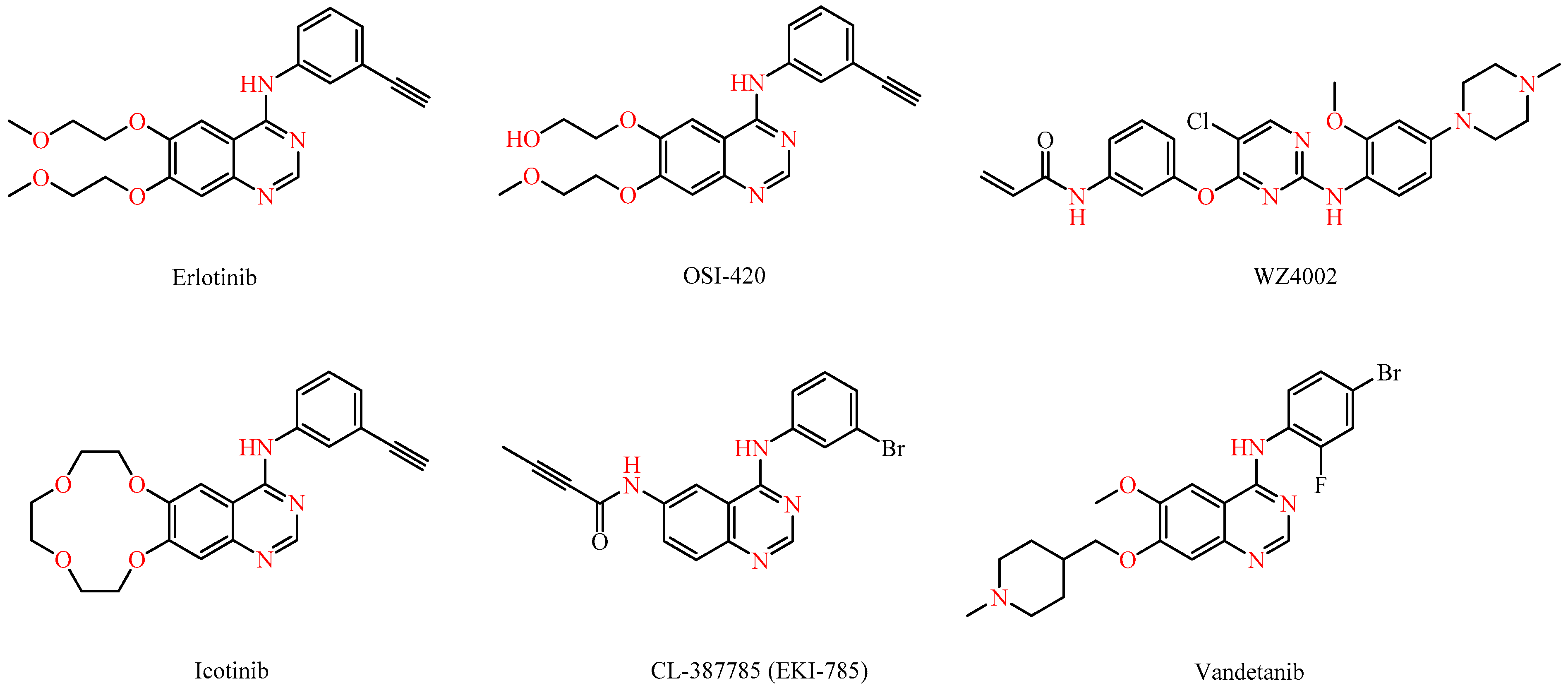
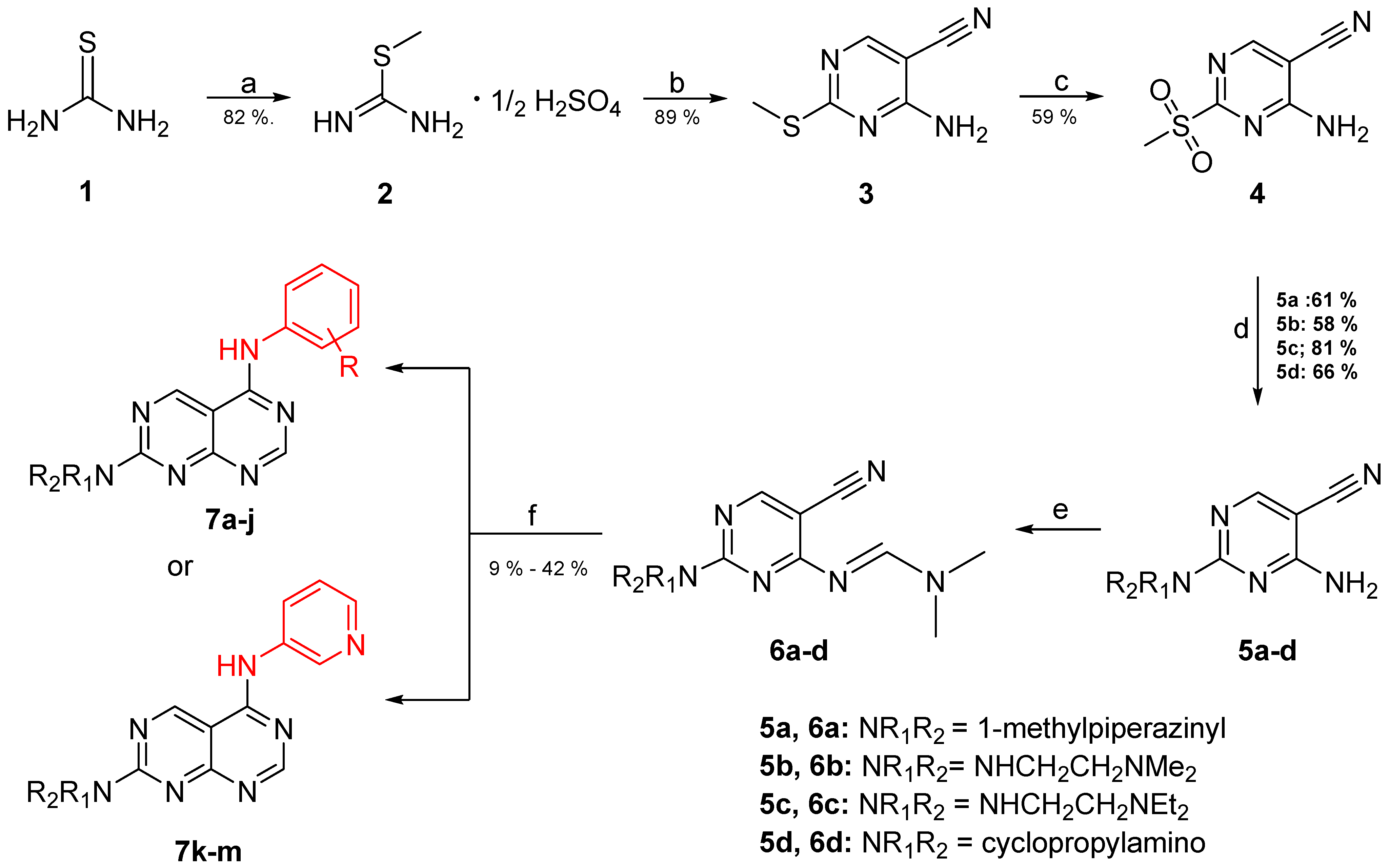
| Compd. | Core | NR1R2 | Compd. | Core | NR1R2 |
|---|---|---|---|---|---|
| 7a |  |  | 7h | 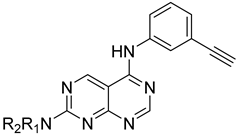 |  |
| 7b |  | 7i |  | ||
| 7c |  | 7j |  | ||
| 7d | 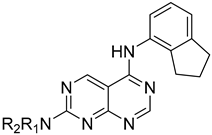 |  | 7k | 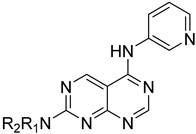 |  |
| 7e |  | 7l |  | ||
| 7f |  | 7m |  | ||
| 7g |  |
| Antiviral Activity (EC50) | Cytotoxicity (CC50) | |||||||||||
|---|---|---|---|---|---|---|---|---|---|---|---|---|
| Compd. | HCoV | Influenza | RSV | HEL299 | Hep3B | MDCK | Hep2 | VeroE6 | ||||
| 229E | OC43 | NL63 | H1N1 | H3N2 | B | A Long | ||||||
| HEL299 | Hep3B | MDCK | Hep2 | |||||||||
| 7a | 15.8 ± 0.9 | 27.7 ± 0.6 | >50 | >50 | >50 | >50 | >50 | >50 | >50 | >50 | >50 | >50 |
| 7b | 11.0 ± 2.7 | 34.7 ± 16.7 | >50 | >50 | >50 | >50 | >50 | >50 | >50 | >50 | >50 | >50 |
| 7c | >50 | >50 | >50 | >50 | >50 | >50 | >50 | >50 | >50 | >50 | >50 | >50 |
| 7d | >50 | >50 | >50 | >50 | >50 | >50 | >50 | >50 | >50 | >50 | >50 | >50 |
| 7e | 20.6 ± 0.3 | >50 | >50 | >50 | >50 | >50 | >50 | >50 | >50 | >50 | >50 | >50 |
| 7f | 3.9 ± 2.9 | 37.3 ± 15.1 | >50 | >50 | >50 | >50 | >50 | >50 | >50 | >50 | >50 | >50 |
| 7g | ≥30.5 | >50 | >50 | >50 | >50 | >50 | >50 | >50 | >50 | >50 | >50 | >50 |
| 7h | >50 | >50 | >50 | >50 | >50 | >50 | >50 | >50 | >50 | >50 | 29.6 ± 1.6 | >50 |
| 7i | 19.3 ±6.6 | ≥39.8 | >50 | >50 | >50 | >50 | >50 | >50 | 25.7 ± 0.6 | >50 | >50 | >50 |
| 7j | >50 | >50 | >50 | >50 | >50 | >50 | >50 | >50 | >50 | >50 | >50 | >50 |
| 7k | >50 | >50 | >50 | >50 | >50 | >50 | >50 | >50 | >50 | >50 | >50 | >50 |
| 7l | >50 | >50 | >50 | >50 | >50 | >50 | >50 | >50 | >50 | >50 | >50 | >50 |
| 7m | >50 | >50 | >50 | >50 | >50 | >50 | >50 | >50 | >50 | >50 | >50 | >50 |
| Erlotinib | 22.5 ± 10 | >100 | >100 | >100 | >100 | >100 | >100 | >100 | >100 | >100 | >100 | >100 |
| WZ4002 | 41.8 ± 9.8 | >100 | >100 | >100 | >100 | >100 | >100 | >100 | >100 | >100 | >100 | >100 |
| OSI-420 | >100 | >100 | >100 | >100 | >100 | >100 | >100 | >100 | >100 | >100 | 41.0 ± 13.4 | >100 |
| Icotinib | >100 | >100 | >100 | >100 | >100 | >100 | >100 | >100 | >100 | >100 | >100 | >100 |
| CNX-2006 | 1.8 ± 0.2 | 2.2 ± 0.8 | >100 | >100 | >100 | >100 | >100 | 11.1 ± 1.0 | 4.3 ± 1.8 | 1.7 ± 0.4 | 11.7 ± 0.8 | 9.2 ± 1.1 |
| CL-387785 | 0.4 ± 0.2 | 1.8 ± 0.4 | >100 | >100 | >100 | 4.5 ± 1.2 | >100 | >100 | 10.9 ± 0.6 | 7.1 ± 0.4 | 10.4 ± 1.9 | >100 |
| Remdesivir | 0.05 ± 0.04 | 0.14 ± 0.007 | 0.14 ± 0.04 | - | - | - | 0.008 ± 0.001 | >10 | 8.1 ± 2.5 | - | 9.0 ± 1.3 | - |
| Ribavirin | 38.9 ± 1.7 | 100.1 ± 19.0 | 39.9 ± 7.1 | 9.6 ± 1.0 | 7.2 ± 1.6 | 7.4 ± 0.8 | 35.9 ± 1.3 | >250 | 165.1 ± 20.2 | >250 | 88.8 ± 23.5 | >250 |
| Zanamivir | - | - | - | 0.6 ± 0.3 | 3.0 ± 0.2 | 0.4 ± 0.01 | - | - | - | >100 | - | - |
| Rimantadine | - | - | - | 1.7 ± 0.5 | 0.6 ± 0.07 | >100 | - | - | - | >100 | - | - |
| Anti-Proliferative Activity (IC50) | ||||||||
|---|---|---|---|---|---|---|---|---|
| Compd. | LN-229 | Capan-1 | HCT-116 | NCI-H460 | DND-41 | HL-60 | K-562 | Z-138 |
| 7a | >100 | >100 | >100 | >100 | 57.9 ± 2.0 | >100 | 87.0 ± 1.3 | 58.9 ± 1.8 |
| 7b | >100 | >100 | >100 | >100 | 67.1 ± 4.7 | >100 | >100 | 62.6 ± 0.8 |
| 7c | >100 | >100 | >100 | >100 | >100 | >100 | >100 | >100 |
| 7d | >100 | >100 | >100 | >100 | 80.6 ± 10.2 | ≥71.0 | 61.3 ± 2.4 | 56.5 ± 1.2 |
| 7e | >100 | >100 | >100 | >100 | >100 | >100 | >100 | >100 |
| 7f | >100 | >100 | >100 | >100 | >100 | >100 | >100 | >100 |
| 7g | >100 | >100 | >100 | >100 | >100 | >100 | >100 | >100 |
| 7h | 97.1 ± 1.5 | >100 | >100 | >100 | 66.5 ± 0.8 | 79.1 ± 4.6 | 52.3 ± 4.4 | 52.6 ± 1.4 |
| 7i | >100 | >100 | >100 | >100 | 62.6 ± 0.1 | >100 | 51.8 ± 3.5 | 62.1 ± 0.8 |
| 7j | >100 | >100 | >100 | >100 | >100 | >100 | >100 | >100 |
| 7k | >100 | >100 | >100 | >100 | >100 | >100 | >100 | >100 |
| 7l | >100 | >100 | >100 | >100 | >100 | >100 | >100 | >100 |
| 7m | >100 | >100 | >100 | >100 | >100 | >100 | >100 | >100 |
| Erlotinib | >100 | 18.6 ± 1.1 | >100 | >100 | >100 | 10.7 ± 0.1 | >100 | >100 |
| WZ4002 | >100 | >100 | >100 | >100 | >100 | >100 | >100 | >100 |
| OSI-420 | >100 | 41.7 ± 3.6 | >100 | >100 | >100 | >100 | >100 | >100 |
| Icotinib | >100 | >100 | >100 | >100 | >100 | >100 | >100 | >100 |
| CNX-2006 | 8.2 ± 1.2 | 1.7 ± 0.01 | 6.6 ± 0.7 | 8.7 ± 1.9 | 4.5 ± 0.2 | 3.8 ± 1.4 | 11.5 ± 0.06 | 2.6 ± 0.5 |
| CL-387785 | 43.8 ± 6.7 | 0.1 ± 0.01 | 1.3 ± 1.1 | 2.8 ± 0.6 | 0.9 ± 0.2 | 1.9 ± 0.04 | 65.0 ± 0.2 | 0.2 ± 0.1 |
| Etoposide | 3.0 ± 0.2 | 0.1 ± 0.03 | 1.4 ± 0.09 | 2.2 ± 0.8 | 0.1 ± 0.02 | 0.2 ± 0.01 | 6.0 ± 2.0 | 0.08 ± 0.03 |
Disclaimer/Publisher’s Note: The statements, opinions and data contained in all publications are solely those of the individual author(s) and contributor(s) and not of MDPI and/or the editor(s). MDPI and/or the editor(s) disclaim responsibility for any injury to people or property resulting from any ideas, methods, instructions or products referred to in the content. |
© 2024 by the authors. Licensee MDPI, Basel, Switzerland. This article is an open access article distributed under the terms and conditions of the Creative Commons Attribution (CC BY) license (https://creativecommons.org/licenses/by/4.0/).
Share and Cite
Georgiou, E.A.; Paraskevas, K.; Koutra, C.; Persoons, L.; Schols, D.; De Jonghe, S.; Kostakis, I.K. Exploring 4,7-Disubstituted Pyrimido[4,5-d]pyrimidines as Antiviral and Anticancer Agents. Molecules 2024, 29, 5549. https://doi.org/10.3390/molecules29235549
Georgiou EA, Paraskevas K, Koutra C, Persoons L, Schols D, De Jonghe S, Kostakis IK. Exploring 4,7-Disubstituted Pyrimido[4,5-d]pyrimidines as Antiviral and Anticancer Agents. Molecules. 2024; 29(23):5549. https://doi.org/10.3390/molecules29235549
Chicago/Turabian StyleGeorgiou, Eleftheria A., Konstantinos Paraskevas, Christina Koutra, Leentje Persoons, Dominique Schols, Steven De Jonghe, and Ioannis K. Kostakis. 2024. "Exploring 4,7-Disubstituted Pyrimido[4,5-d]pyrimidines as Antiviral and Anticancer Agents" Molecules 29, no. 23: 5549. https://doi.org/10.3390/molecules29235549
APA StyleGeorgiou, E. A., Paraskevas, K., Koutra, C., Persoons, L., Schols, D., De Jonghe, S., & Kostakis, I. K. (2024). Exploring 4,7-Disubstituted Pyrimido[4,5-d]pyrimidines as Antiviral and Anticancer Agents. Molecules, 29(23), 5549. https://doi.org/10.3390/molecules29235549








